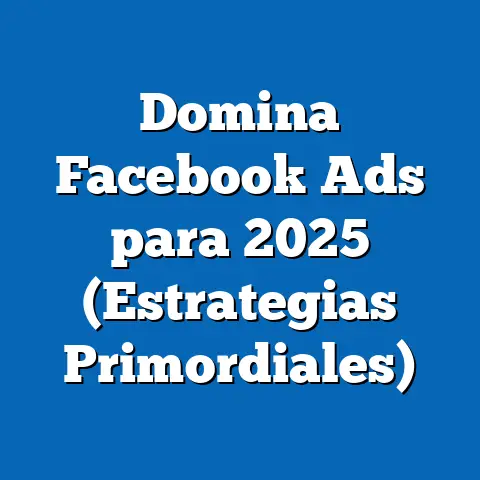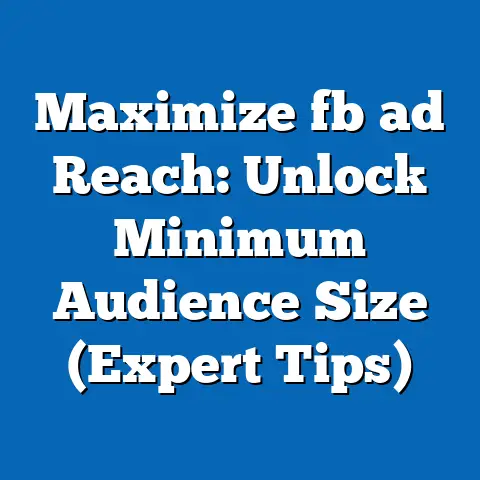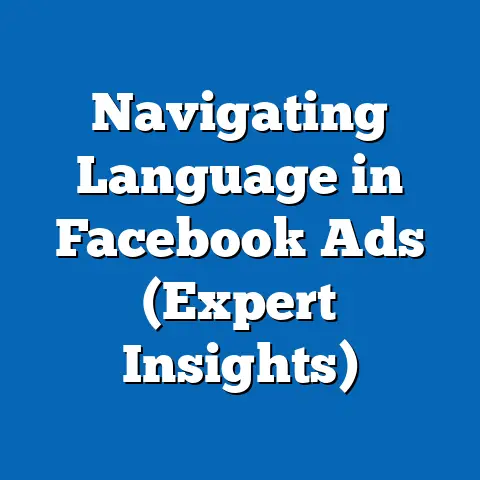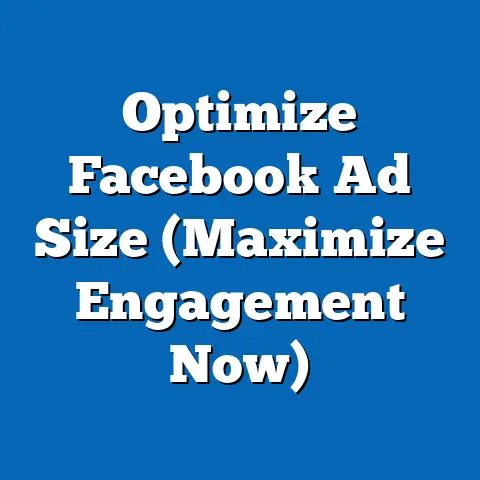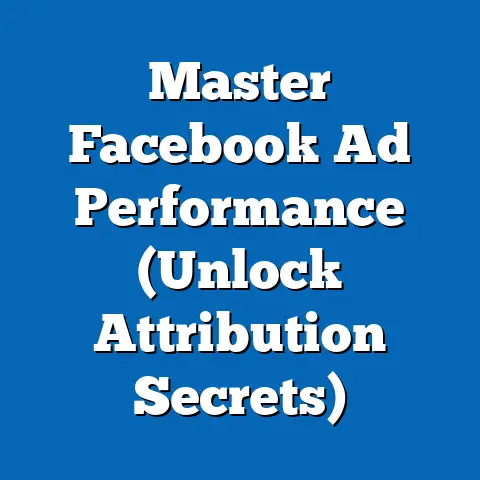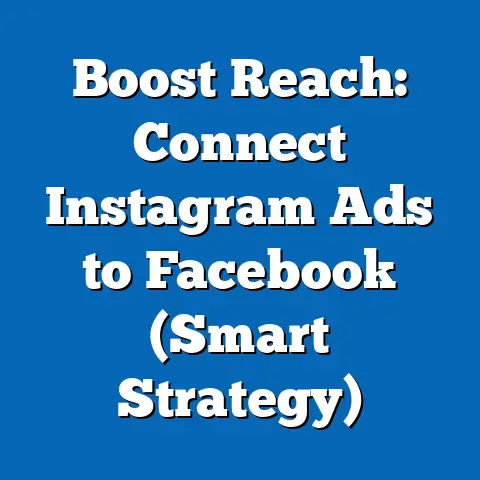Maximize Results with Facebook Video Ads (Expert Strategies)
Video has exploded as the king of content, and if you’re not leveraging it in your Facebook advertising strategy, you’re leaving money on the table. Think about it: how often do you scroll through your feed and stop on a captivating video? I know I do! It’s not just anecdotal; studies show that video ads have higher engagement rates and can significantly improve brand recall compared to static images.
But simply throwing up any video won’t cut it. To truly maximize your results, you need a strategic approach. This article is your deep dive into expert strategies for Facebook video ads, pulling together insights from industry leaders and my own experiences to help you create campaigns that convert. We’ll cover everything from crafting compelling content to understanding Facebook’s algorithm and optimizing for maximum impact. So, buckle up, and let’s transform your video ads from mediocre to magnificent!
Expert Picks – Top Strategies for Facebook Video Ads
When it comes to Facebook video ads, the landscape is constantly evolving. What worked six months ago might not be as effective today. That’s why I always keep an ear to the ground, listening to the experts and analyzing successful campaigns. Here are some top strategies that are consistently recommended by leading voices in the digital marketing world:
Engaging Storytelling: Hook, Line, and Sinker
David Ogilvy, the “Father of Advertising,” famously said, “Tell the truth, but make the truth fascinating.” This holds especially true for video ads. People don’t want to be bombarded with sales pitches; they crave stories that resonate with their emotions and values.
Why it matters: Storytelling creates an emotional connection with your audience. It makes your brand relatable and memorable.
How to do it:
- Identify your target audience’s pain points: What are their challenges, aspirations, and desires?
- Craft a narrative that addresses those pain points: Show how your product or service can help them overcome their obstacles and achieve their goals.
- Focus on the benefits, not just the features: Instead of simply listing what your product does, explain how it will improve their lives.
Example: Dove’s “Real Beauty Sketches” campaign is a masterclass in storytelling. It didn’t directly sell soap; instead, it sparked a global conversation about beauty standards and self-perception. This emotional resonance made the campaign incredibly impactful and memorable. I remember when that ad came out. It made me, and many others, stop and think about how we perceive ourselves. It was a powerful example of using video to create a genuine connection.
Target Audience Analysis: Precision Targeting for Maximum Impact
Facebook’s targeting capabilities are incredibly powerful. You can target users based on demographics, interests, behaviors, and even custom audiences created from your existing customer data. But with great power comes great responsibility – you need to use these tools wisely.
Why it matters: Showing your video ad to the wrong audience is like shouting into the void. You’ll waste your budget and get little to no results.
How to do it:
- Define your ideal customer: Create detailed buyer personas that outline their demographics, interests, pain points, and purchasing habits.
- Utilize Facebook’s targeting options: Experiment with different combinations of demographics, interests, and behaviors to find the most responsive audience.
- Create custom audiences: Upload your customer list or website visitor data to create highly targeted audiences of people who are already familiar with your brand.
- Leverage lookalike audiences: Expand your reach by targeting users who are similar to your existing customers.
Example: Let’s say I’m running a campaign for a new line of organic baby food. Instead of broadly targeting “parents,” I would use Facebook’s targeting options to reach parents who are interested in organic food, natural parenting, and baby health. I might also create a custom audience of people who have visited my website or signed up for my email list. This laser-focused approach will ensure that my video ad is seen by the people who are most likely to be interested in my product.
Short and Sweet Content: Respecting the Scroll
In today’s fast-paced world, attention spans are shorter than ever. That’s why experts recommend keeping your Facebook video ads concise and engaging.
Why it matters: People are bombarded with content every day. If your video doesn’t grab their attention quickly, they’ll simply scroll past.
How to do it:
- Get to the point quickly: Don’t waste time with lengthy intros or irrelevant information.
- Focus on the most important message: Highlight the key benefit or value proposition of your product or service.
- Keep it under 15-30 seconds: This is the sweet spot for optimal engagement on Facebook. I’ve personally found that even shorter videos, around 6-10 seconds, can be incredibly effective for grabbing attention and driving brand awareness.
- Use strong visuals and music: Create a visually appealing and aurally engaging experience that captures the viewer’s attention.
Example: A quick, visually appealing video showcasing the before-and-after results of using a skincare product, set to upbeat music, is far more likely to grab attention than a long, drawn-out explanation of the product’s ingredients.
Strong Visuals and Branding: Making a Lasting Impression
Your video ad is a visual representation of your brand. It needs to be high-quality, visually appealing, and consistent with your brand identity.
Why it matters: Strong visuals and branding create a positive impression and help people remember your brand.
How to do it:
- Use high-resolution footage: Avoid grainy or pixelated visuals.
- Maintain brand consistency: Use your brand colors, fonts, and logo throughout the video.
- Create a visually appealing aesthetic: Use good lighting, composition, and editing techniques to create a visually engaging experience.
- Showcase your product or service in action: Demonstrate how it works and highlight its key benefits.
Example: Apple is a master of visual branding. Their video ads are always sleek, minimalist, and visually stunning. They showcase their products in a way that is both aspirational and relatable.
Key Takeaway: These expert strategies are not just theoretical concepts; they are proven methods for maximizing results with Facebook video ads. By incorporating storytelling, targeting, brevity, and strong visuals into your campaigns, you can create video ads that capture attention, engage your audience, and drive conversions.
Understanding Facebook’s Algorithm and Ad Placement
Facebook’s algorithm is the gatekeeper that determines which content users see in their newsfeeds. Understanding how it works is crucial for maximizing the reach and impact of your video ads.
How the Algorithm Works:
Facebook’s algorithm prioritizes content that is:
- Relevant: Content that is likely to be of interest to the user based on their past behavior.
- Engaging: Content that generates likes, shares, comments, and other forms of interaction.
- Timely: Recent content that is fresh and relevant to current events.
- From trusted sources: Content from sources that the user trusts and interacts with regularly.
Ad Placement Options:
Facebook offers a variety of ad placement options, including:
- Facebook Feed: This is the most common placement option, where your video ad appears in the user’s newsfeed alongside organic content.
- Facebook Stories: This placement option allows you to create short, vertical video ads that appear between users’ stories.
- Facebook Marketplace: This placement option allows you to showcase your video ads to users who are actively browsing products and services in the Marketplace.
- In-Stream Videos: This placement puts your ad in front of viewers already engaged with video content.
- Audience Network: Extends your reach beyond Facebook to other apps and websites.
Expert Recommendations:
Experts recommend testing different ad placements to determine which yields the best results for your specific campaign goals. For example, if you’re trying to drive brand awareness, Facebook Stories might be a good option. If you’re trying to generate leads, Facebook Feed might be more effective.
Analyzing Performance Data:
It’s essential to analyze your performance data to understand which placements are working best and optimize your campaigns accordingly. Facebook Ads Manager provides a wealth of data on ad performance, including reach, impressions, engagement, and conversions.
Why it matters: I’ve learned that understanding the algorithm and experimenting with different placements significantly impacts ad performance. For example, I once ran a campaign where I assumed Facebook Feed would be the best placement. However, after testing, I discovered that Facebook Stories generated a much higher engagement rate and lower cost per acquisition.
Key Takeaway: Don’t just blindly choose ad placements. Take the time to understand how Facebook’s algorithm works and experiment with different placements to find the optimal combination for your campaign goals.
Crafting Compelling Video Content
Creating compelling video content is the heart of a successful Facebook video ad campaign. Here’s a breakdown of key elements:
Attention-Grabbing Intros: The First Few Seconds Matter
You only have a few seconds to grab a viewer’s attention. That’s why your video ad needs to start with a bang.
How to do it:
- Use a hook: Start with a question, a surprising statement, or a visually intriguing scene.
- Showcase the problem: Immediately address the pain point that your product or service solves.
- Create a sense of urgency: Make viewers feel like they need to watch the rest of the video to learn more.
Example: Instead of starting with your brand logo, begin with a shot of someone struggling with the problem your product solves. Then, quickly transition to showcasing the solution.
Clear Call-to-Action (CTA): Guiding the Viewer
A strong CTA is essential for driving conversions. Your CTA should be clear, concise, and directly related to your campaign goals.
How to do it:
- Use action-oriented language: Use verbs like “Shop Now,” “Learn More,” or “Sign Up.”
- Make it visually prominent: Use a button or text overlay to highlight your CTA.
- Place it at the end of the video: Give viewers time to understand your message before asking them to take action.
Example: Instead of a generic “Visit Our Website” CTA, use a more specific CTA like “Shop Our New Collection Now” or “Download Your Free Guide Today.”
Using Subtitles and Text Overlays: Accessibility and Engagement
Many people watch videos with the sound off, especially on mobile devices. That’s why it’s crucial to add subtitles and text overlays to your video ads.
How to do it:
- Add subtitles: Use Facebook’s built-in subtitle tool or a third-party app to add subtitles to your video.
- Use text overlays: Highlight key messages or benefits with text overlays that appear on the screen.
- Keep it concise: Use short, easy-to-read text that complements the visuals.
Example: I always add subtitles to my video ads, especially when targeting younger audiences. I’ve found that it significantly increases engagement and view-through rates.
Testing Different Formats: Finding What Resonates
Facebook supports a variety of video formats, including live videos, animated videos, and user-generated content. Experiment with different formats to see which resonates best with your audience.
How to do it:
- Live videos: Use live videos to connect with your audience in real-time and answer their questions.
- Animated videos: Use animated videos to explain complex concepts or showcase your brand personality.
- User-generated content: Use user-generated content to build trust and credibility.
Example: I’ve had great success with user-generated content, especially for product reviews. Customers are more likely to trust the opinions of other customers than they are to trust marketing messages from a brand.
Key Takeaway: Crafting compelling video content requires a combination of creativity, strategy, and attention to detail. By focusing on attention-grabbing intros, clear CTAs, accessibility, and format testing, you can create video ads that capture attention, engage your audience, and drive results.
Measuring Success and Optimizing Campaigns
Measuring the success of your Facebook video ad campaigns is crucial for understanding what’s working and what’s not. Here are some key performance indicators (KPIs) that experts recommend tracking:
View-Through Rate (VTR): Measuring Engagement
VTR is the percentage of people who watch your video to completion. It’s a good indicator of how engaging your video is.
How to interpret it: A high VTR indicates that your video is capturing and holding viewers’ attention. A low VTR suggests that your video is not engaging or that you’re targeting the wrong audience.
How it relates to other metrics: VTR is closely related to engagement rate and conversion rate. If people are watching your video to completion, they’re more likely to engage with it and take the desired action.
Engagement Rate: Measuring Interaction
Engagement rate measures the number of likes, shares, comments, and other interactions your video receives. It’s a good indicator of how well your video is resonating with your audience.
How to interpret it: A high engagement rate indicates that your video is sparking conversations and building relationships with your audience. A low engagement rate suggests that your video is not relevant or interesting to your target audience.
How it relates to other metrics: Engagement rate is closely related to VTR and conversion rate. If people are engaging with your video, they’re more likely to watch it to completion and take the desired action.
Conversion Rate: Measuring Results
Conversion rate measures the percentage of people who take the desired action after watching your video. This could be anything from visiting your website to making a purchase.
How to interpret it: A high conversion rate indicates that your video is effectively driving results. A low conversion rate suggests that your video is not compelling enough or that your landing page is not optimized for conversions.
How it relates to other metrics: Conversion rate is the ultimate measure of success for your video ad campaign. It’s directly related to VTR and engagement rate. If people are watching your video to completion and engaging with it, they’re more likely to convert.
A/B Testing: Optimizing for Success
A/B testing involves creating two versions of your video ad and testing them against each other to see which performs better.
How to do it:
- Test different headlines: Experiment with different headlines to see which grabs the most attention.
- Test different visuals: Experiment with different visuals to see which resonates best with your audience.
- Test different CTAs: Experiment with different CTAs to see which drives the most conversions.
- Test different targeting options: Experiment with different targeting options to see which reaches the most responsive audience.
Example: I always A/B test my video ads, even if I think I know what will work best. I’ve been surprised many times by which version performs better.
Using Facebook Ads Manager: Data-Driven Decisions
Facebook Ads Manager provides a wealth of data on ad performance. Use this data to make informed adjustments to your campaigns and improve your results.
How to do it:
- Monitor your KPIs: Track your VTR, engagement rate, and conversion rate on a regular basis.
- Identify trends: Look for patterns in your data to understand what’s working and what’s not.
- Make adjustments: Based on your data, adjust your targeting options, ad creative, or budget to improve your results.
Key Takeaway: Measuring success and optimizing campaigns is an ongoing process. By tracking your KPIs, A/B testing your ads, and using Facebook Ads Manager to analyze your data, you can continuously improve your results and maximize your ROI.
Conclusion
Facebook video ads are a powerful tool for reaching your target audience and driving conversions. By following the expert strategies outlined in this article, you can create video ads that capture attention, engage your audience, and deliver results. Remember to focus on storytelling, target your audience precisely, keep your videos concise, use strong visuals, and continuously measure and optimize your campaigns.
I’ve seen firsthand the transformative power of well-executed Facebook video ads. They can build brand awareness, generate leads, and drive sales. The key is to approach them strategically and to never stop learning and experimenting. Now, I encourage you to take these strategies and implement them in your own campaigns. Share your experiences and insights in the comments below. Let’s learn from each other and elevate our Facebook video ad game!

